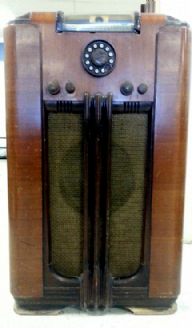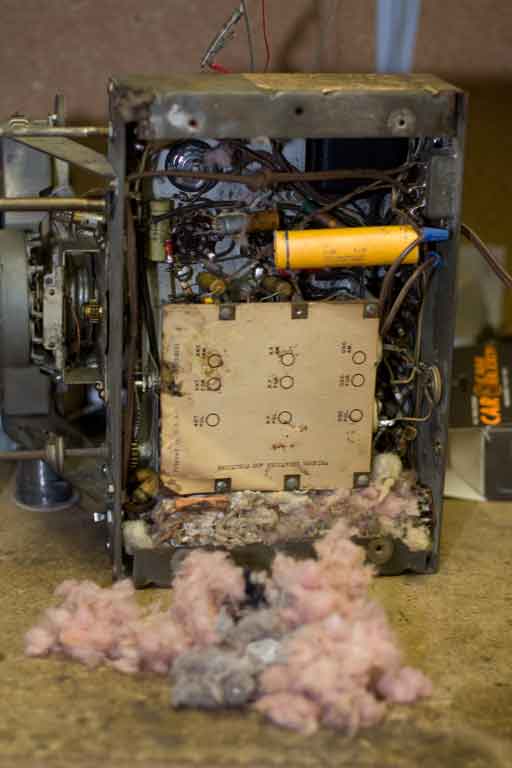Please note: this radio is no longer in my collection.
 Silvertone was the house brand for Sears Roebuck, a major US department store chain and mail order company. As I type this in 2017, they're a shadow of their former selves; at one time they were huge. They were a big seller of radios (and everything else); the Silvertone name doesn't carry the same kind of nostalgia that Zenith and Philco do, but there are a lot of Silvertones out there—because people bought them.
Silvertone was the house brand for Sears Roebuck, a major US department store chain and mail order company. As I type this in 2017, they're a shadow of their former selves; at one time they were huge. They were a big seller of radios (and everything else); the Silvertone name doesn't carry the same kind of nostalgia that Zenith and Philco do, but there are a lot of Silvertones out there—because people bought them.
Originally I bought this because it was on a thrift shop auction site for $10 with no takers; I finally got it the 4th time it was listed. It was out of town but I had a friend who lived nearby who was willing to get it for me. Otherwise it might still be there.
I never paid much attention to Silvertones; I usually lump them in with Montgomery Ward Airlines as being stuffy, conservatively drab, low- to mid-tier appliances. But this is actually quite a radio. The styling is understated but the mechanicals are feature rich. In addition to the magic eye (I'll buy almost anything with a magic eye), and the extra coverage for world band reception (up to 18 Mhz), it's got "whisper tuning," which is supposed to blank out the noise between stations, and eleven station presets in a telephone dial configuration, and it's also got a variable selectivity switch for use on the short wave bands.
Ten tubes run this beast: the common 5Y3 rectum-fryer; my favorite the 6E5 magic eye; two 6K7s (I've got a raft of those, thanks to my Rider Chanalyst debacle) RF/IF amps, a 6A8 converter, a 6Q7 AVC/2nd detector, and a 6J5 inverter for the pair of 6V6 power out tubes.
The chassis is model 101.196. Sears model nomenclature used a three digit number for the maker followed by a decimal and then a model number designator (Montgomery Ward did the same thing). If you know the three digit model identifiers, you know who made the unit. Sears bought radios from a number of different makers. According to Mark Stein's Sears Silvertone Catalog 1930-1942, 101 was Colonial.
I'm trying to keep the number of open projects down to a minimum, so this one is back a few places in the queue. But I did pull the chassis, since it was something I could do quickly and easily, do check it out. I was hoping maybe it would play right off the bat.
Well—no. One of the electrolytic cans began to leak; that'll have to be replaced before I do much else. And the dial cord is off and wound around everything.
 How do the tubes look? The 5Y3 rectifier has a broken center pin but that shouldn't matter, but it tests stone cold dead. The two 6Q7s are testing extremely weak. So does the magic eye. The nice thing about the eye tube is that I can actually see how faint the eye is, whereas the 6Q7s are just meter readings.
How do the tubes look? The 5Y3 rectifier has a broken center pin but that shouldn't matter, but it tests stone cold dead. The two 6Q7s are testing extremely weak. So does the magic eye. The nice thing about the eye tube is that I can actually see how faint the eye is, whereas the 6Q7s are just meter readings.
Most of the tubes on the chassis are shielded, except for the twin 6V6 audio-output tubes. Two of the tubes were missing shields; I assume that they were originally all G type tubes—big bulbous glass envelopes. The two that were missing shields were metal types, and they were shorter than their G equivalents. These have tin hats, so if the tube is too short, the wire cap won't reach far enough to connect with the shields in place. Since the metal tubes are self shielded, whoever replaced the tubes just tossed the shields.
Electrically it's equivalent, but I wanted it to look "right". Nigel Marshall was kind enough to send me a pair gratis, and I replaced the tubes with G types so the caps would fit.
There are two 6V6s in push-pull configuration. One on the chassis is a 6V6G and the other is a GT, which makes them an odd pair. I ended up relacing the GT with a G so that they match. I think it improves the look of the chassis. The back of the console is wide open so you can easily see everything. If it were a tabletop with a covered back, I probably wouldn't bother.
Underneath the chassis, it appears something decided to build a nest. Lots of batting and thread and bits of this and that. Whatever it was, it had to be small to get in there. No sign of what it might have been.
Escutcheon
The escutcheon (the trim piece that goes around the clear dial cover on the front of the radio) for my Silvertone console was broken. According to others I've talked to, this is very common. The plastic they used in 1937 (I don't know what type) is prone to shrink and warp over time. Considering it's now 80 years old, as I type this in 2017, it's aging about the same way a human does.
Getting another escutcheon was probably impossible unless I was willing to buy another radio with a good eschutcheon and use the radio as a parts donor. That left another option: 3D printing.
As this is a whole new thing to me, I've decided to give the 3D-printed escutcheon its own page.
Service Tip
I found this in Radio Retailing magazine, January 1939, P. 80:
Large 140Ω flexible resistor located at 6V6G socket gets hot to smoking point . . . look for trouble in the .003 µfd condensers from plate to cathode of 6V7G tubes.
Current status
This radio is no longer in my collection. This page will probably be removed in late 2024.
Other sources
SQCRA has a nice article on restoring a Model 4766, which is a twin-speaker table model version with nearly the same chassis. The website is in French but the article is in Englsh.
An article from Radio-Antiks about the 4666 regarding a single-speaker table-model.

